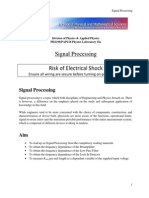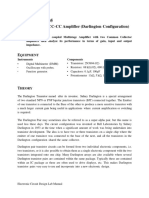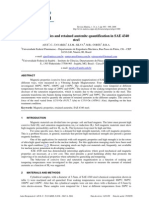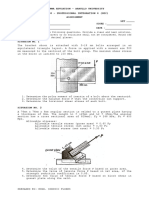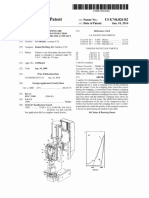Optical Lab - REC
Optical Lab - REC
Uploaded by
Giri KanyakumariCopyright:
Available Formats
Optical Lab - REC
Optical Lab - REC
Uploaded by
Giri KanyakumariOriginal Description:
Copyright
Available Formats
Share this document
Did you find this document useful?
Is this content inappropriate?
Copyright:
Available Formats
Optical Lab - REC
Optical Lab - REC
Uploaded by
Giri KanyakumariCopyright:
Available Formats
www.Vidyarthiplus.
com
www.Vidyarthiplus.com Page 1
EXPERIMENT 01
SETTING UP FIBER OPTIC ANALOG LINK
OBJECTIVE:
The objective of this experiment is to study a 650 nm fiber
optic analog link. In this experiment, we will study a relationship between
the input signal and the received signal.
PROCEDURE:
1. Connect the power supply to the board.
2. Ensure that all switch faults are OFF.
3. Make the following connections.
a. Connect the function generator 1 KHz sine wave output to the
emitter 1s input.
b. Connect the fiber optic cable between the emitters output and
detectors input.
c. Connect detectors output to the AC amplifier 1s input.
4. On the board switch emitter 1s driver to analog mode.
5. Switch ON the power.
6. Observe the input to emitter (tp 5) with output from AC amplifier 1
(tp 28) and note that the two signals are same.
RESULT:
Thus the relationship between input and output waves was
obtained.
www.Vidyarthiplus.com
www.Vidyarthiplus.com Page 2
SETTING UP FIBER OPTIC ANALOG LINK
Emitter circuit Detector circuit
Function Generator AC Amplifier
1 KHz Circuit
OBSERVATION
Input Voltage
(V)
Output Voltage
(V)
Time
(ms)
Gnd
www.Vidyarthiplus.com
www.Vidyarthiplus.com Page 3
EXPERIMENT 02
SETTING UP FIBER OPTIC DIGITAL LINK
OBJECTIVE:
The objective of this experiment is to study a 650 nm fiber
optic digital link. In this experiment, we will study a relationship between
the input signal and the received signal.
PROCEDURE:
7. Connect the power supply to the board.
8. Ensure that all switch faults are OFF.
9. Make the following connections.
a. Connect the function generator 1 KHz square wave output to
the emitter 1s input.
b. Connect the fiber optic cable between the emitters output and
detectors input.
c. Connect detector 1s output to the comparator 1s input.
d. Connect comparator 1s output to AC amplifier 1s input.
10. On the board switch emitter 1s driver to digital mode.
11. Switch ON the power.
12. Monitor both the inputs to comparator 1 (tp 13 and tp 14). Slowly
adjust the comparator bias. Reset until DC level on the input (tp 13)
lies midway between the high and low level of the signal on positive
input (tp 14).
13. Observe the input to emitter (tp 5) with output from AC amplifier 1
(tp 28) and note that the two signals are same.
RESULT:
Thus the relationship between input and output waves was
obtained.
Frequency (KHz) =
www.Vidyarthiplus.com
www.Vidyarthiplus.com Page 4
SETTING UP FIBER OPTIC DIGITAL LINK
Emitter circuit Detector circuit
AC amplifier
Circuit
OBSERVATION
Input Voltage
(V)
Output Voltage
(V)
Time
(ms)
Function
Generator
1 KHz
Comparator
Gnd
www.Vidyarthiplus.com
www.Vidyarthiplus.com Page 5
EXPERIMENT 04
STUDY OF BENDING LOSS AND PROPAGATION LOSS IN
OPTICAL FIBRE
Objective:
The objective of this experiment is to measure the propagation loss and the
bending loss in the optical fibre.
Theory:
Attenuation loss (or path propagation loss) is the reduction in power density
(attenuation) of an electromagnetic wave as it propagates through space. Attenuation loss
is a major component in the analysis and design of the link budget of a
telecommunication system.
Attenuation occurring as a result of either a bend in an optical fibre that exceeds
the minimum bend radius or an abrupt discontinuity in the core/cladding interface is
called bending loss. The incident light rays strike the boundary between the core and the
cladding at an angle less than the critical angle and enter the cladding, where they are lost
Procedure:
i)To find propagation loss:
1. Connect the power supply to the board.
2. Make the following connections
a) Function generators 1KHz sinewave output to input 1 socket of emitter 1 circuit via
4mm lead.
b) Connect 0.5m optic fibre between emitter 1 output and detector 1s input.
c) Connect detector 1 output to amplifier 1 input socket via 4mm lead.
3. Switch ON the power supply.
4. Set the oscilloscope channel 1 to 0.5V /div and adjust 4-6 div amplitude by using x1
probe with
the help of variable pot in function generator block input 1 of emitter 1.
5. Observe the output signal from detector t p 10 on CRO.
6. Adjust the amplitude of the received signal as that of transmitted one with the help of
gain adjust
pot in AC amplifier block. Note this amplitude and name it V1.
7. Now replace the previous FO cable with 1m cable without disturbing any previous
setting.
8. Measure the amplitude at the receiver side again at output of amplifier 1 socket t p 28.
Note this
value and name it V2.
9. Calculate propagation (attenuation) loss with the help of following formula
V1/V2 = exp(-(L1+L2))
www.Vidyarthiplus.com
www.Vidyarthiplus.com Page 6
Where is loss in nepers/m
1 neper = 8.686dB
L1 = length of shorter cable (0.5m)
L2 = length of longer cable (1m)
ii)To find bending loss
1. Repeat all steps from 1-6 of the above procedure using 1m cable.
2. Wind FO cable on the Mandrel and observe the corresponding AC amplifier
output on CRO.
It will be gradually reducing showing loss due to bends.
Block diagram:
Study of Propagation
Loss
Study of Bending Loss
www.Vidyarthiplus.com
www.Vidyarthiplus.com Page 7
Results:
Thus the propagation and bending losses in the fibre optic was measured and
studied by this experiment.
EXPERIMENT 05
Characteristics of F O communication Link
OBJECTIVE
The aim of experiment is to study the Vin (a.c.) versus Vo (a.c.).
THEORY
Fiber-optic communication is a method of transmitting information from one
place to another by sending pulses of light through an optical fiber. The process of
communicating using fiber-optics involves the following basic steps: Creating the
optical signal involving the use of a transmitter, relaying the signal along the fiber,
www.Vidyarthiplus.com
www.Vidyarthiplus.com Page 8
ensuring that the signal does not become too distorted or weak, receiving the optical
signal, and converting it into an electrical signal.
PROCEDURE
(1) Connect power supply to board (as shown in diagram).
(2) Make the following connections
(a) Function Generator 1KHZ sinewave output to input socket of emitter
1 circuit. Via 4mm lead.
(b) Connect optic fiber between emitter 1s output and detector 1s input.
(c) Connect Detector 1 output to amplifier 1 input socket via 4nm lead.
(3) Switch ON the power supply.
(4) Set the amplitude of the function generator to 2 V p-p.
(5) Observe the transmitted and received signal on CRO. Vo(output voltage)
Should be in the same order as Vin (input voltage)
(6) Next set Vin to suitable values and note the values of Vo.
(7) Tabulate and plot a graph Vo versus Vin and & compute Vo/Vin.
RESULT
Thus the characteristics of fiber optic communication link was studied and also
the graph Vin (a.c.) versus Vo(a.c.) was plotted.
BLOCK DIAGRAM
www.Vidyarthiplus.com
www.Vidyarthiplus.com Page 9
EXPERIMENT 06
CHARACTERISTICS OF E-O CONVERTER
Objective
The aim of this experiment is to study the operation of LED.
Theory
LEDs and LASER diodes are the commonly used sources in optical communication
systems, whether the system transmits digital or analog signal. It is therefore, often
necessary to use linear Electrical to Optical converter to allow its use in intensity
modulation & high quality analog transmission systems. LEDs have a linear optical
output with relation to the forward current over a certain region of operation
Procedure
1) Connect power supply to the board
2) Ensure that all switched faults are in OFF condition
3) Put emitter 1 block in DIGITAL MODE
4) Make connections as shown in diagram
www.Vidyarthiplus.com
www.Vidyarthiplus.com Page 10
a) Connect the Bias 1 preset on comparator 1 (tp 13) to the emitter 1 output
at (tp 5)
b) Adjust the bias 1 preset to its minimum setting fully counter clockwise.
Now look down the emitter 1 LED Socket and slowly advance the seting
of the bias 1 preset until in subdued lighting the light from LED is just
visible
5) Connect the DMM between +12 V supply and tp 6, the cathode of LED. The
DMM will now read the forward voltage (Vf)
6) Measure the voltage drop across the 2 K (R 9) current limiting resistor by
connecting DMM between tp 6 and tp 38. the forward current is given by dividing
the readings by 2 K. This (If) is known as threshold current.
DVM reading mA
2000
7) Vary the bias 1 preset so as to vary the forward voltage (as 1.3,1.4,.1.7), note
the corresponding (If) forward current
8) Record these values of Vf and If. Plot the characteristics between these two.
Tabular column
FORWARD
VOLTAGE
DVM READING THRESHOLD
CURRENT
Result
Thus the operation of LED was studied and the characteristic was plotted.
Block diagram
www.Vidyarthiplus.com
www.Vidyarthiplus.com Page 11
EXPERIMENT 07
MESUREMENT OF FREQUENCY AND WAVELENGTH
AIM: To determine the frequency and wavelength in a rectangular waveguide
working on TE
10
model
APPARATUS REQUIRED: Klystron power supply, Reflex klystron isolator,
frequency meter, variable attenuator, slotted section, VSWR meter, detector mount
& CRO.
THEORY: For dominant TE
10
mode in rectangular waveguide
0
,
g
,
c
are related
as below.
1/
0
2
= 1/
g
2
+ 1/
c
2
Emitter circuits
Detector circuits comparator
Out c1
www.Vidyarthiplus.com
www.Vidyarthiplus.com Page 12
0
= Free space wavelength
g
= guide wavelength
c
= cut off wavelength
For TE10 mode c = 2a where a is the broad dimension of waveguide. The
following relationship can be proved.
c = f
c = velocity of light
f = frequency
PROCEDURE:
1. Obtain the modulated square wave in the CRO.
2. Calibrate the VSWR meter.
3. Adjust the slotted section so as to get the maxima and minima position.
4. Note down the slotted section readings either at minimum or maximum position.
(Any two maximas or minimas).
5. If the reading is taken at maxima point, bring the VSWR meter to maxima point
and rotate the frequency meter so that dip occurs (towards the left end of meter).
6. At dip position note down the frequency meter reading and also note the dB
value from VSWR meter. Immediately rotate the frequency meter back to the
original position so that the pointer reads to maximum position. (Zero position in
VSWR).
7. Calculate the difference between two maximas or two minimas, which gives
g
/2.
8. Calculate the frequency and wavelength using above formula.
www.Vidyarthiplus.com
www.Vidyarthiplus.com Page 13
9. The above experiment can be verified at different frequencies of klystron
operation.
10. The frequency can be varied by rotating the screw in clockwise or anticlockwise
direction which is provided in the reflex klystron.
BLOCK DIAGRAM:
OBSERVATION: LEAST COUNT = .01cm (Slotted line)
LEAST COUNT = .01mm (freq micrometer & attenuator)
FROM SLOTTED SECTION
Trial
No
MSR
VSC
VSR=
VSCx.01
Total
Reading
1.
Klystron
power supply
(0-500)
Reflex
Klystron
Frequency
meter
Attenuator Slotted
Section
Waveguide
detector
mount
CRO (or)
VSWR
meter
www.Vidyarthiplus.com
www.Vidyarthiplus.com Page 14
CALCULATIONS:
g
is calculated from slotted section line
g
/2 = (d
1
n d
2
)
a = dimension of the waveguide = 2.286 x 10
2
m
1/
0
= ((1/
g
)
2
+ (1/2a)
2
)
1/2
f = c/
0
c = 3 x 10
8
m/s
f is calculated and the result is verified from the given table with the
corresponding micrometer reading taken from frequency meter.
FINAL OBSERVATION:
2.
3.
4.
5.
MICROMETER READINGS
PSR
HSC
HSR=
HSCx.01
OBR=
PSR+
HSR
Total
Reading
((OBR
ZC)
1.
2.
3.
4.
5.
www.Vidyarthiplus.com
www.Vidyarthiplus.com Page 15
Micrometer
Reading
g
/2
1/
0
f = c/
0
RESULT: Thus the frequency and wavelength in a rectangular waveguide
working on TE
10
model was determined.
EXPERIMENT 08
MEASUREMENT OF UNKNOWN LOAD
IMPEDANCE
AIM: To determine the impedance of an unknown load using smith chart.
APPARATUS REQUIRED:
Klystron power supply, reflex klystron, isolator , frequency meter , attenuator, slotted
line, matched termination , horn antenna (load), detector mount ,VSWR meter , CRO and
screw driver set.
PROCEDURE:
1. Obtain the modulated square wave in the CRO.
2. Calibrate the VSWR meter .
3. Using the detector mount , find the 2 maximas or minimas by adjusting the
slotted line carriage , to find g/2 or find the dip frequency from directly reading
the frequency meter at the maxima.
4. Connect the horn antenna to the slotted line by removing the detector mount.
5. Connect the CRO to the slotted line and find the VSWR of Horn, by noting down
the maximum and minimum amplitude of the output square waveform.
6. Also find the first minima from the load side and note the value as x1 from the
slotted line.
7. Now replace the horn by matched termination and find the first minima from the
load side and note down the value as x2 from the slotted line.
www.Vidyarthiplus.com
www.Vidyarthiplus.com Page 16
8. The difference (i.e) x2 x1 = x between the 2 readings gives the value x.
9. Using a smith chart , draw a circle of radius equal to the VSWR reading of the
Horn antenna with unity 1 as centre.
10. Move a distance x/g towards the load side or towards the generator depending on
the sign of value x/g (If the value is negative ; then move towards the generator.
If the value is positive; then move towards the load).
11. Move then the distance x/g on the circumferential circle on the smith chart and
mark it.
12. Draw a line joining the centre of VSWR circle with this point.
13. The above line will act as the VSWR circle at a point.
14. Read the value of impedance corresponding to this point which gives the
normalized impedance of Horn using the Smith chart.
15. Using the formula, the characteristic impedance of Horn can be determined and
both the values are used for finding the actual impedance of Horn.
CALCULATION:
g = d1 d2 cm
1/ 0 = [1/g] +[1/2a]
where f= c/0
C = 3* 10 m
f is calculated using g or from the direct readingfrequency meter by finding the dip .
Fc = C/2a ; C = 3* 10 8 M
a = 2.286 * 10 (-2) M
Normalised impedance is ZR = 0.925 + 0.22
Characteristic impedance Z0 = / 1 - [fc / f ]
= 0/ 0 = (4 * 108) / (8.854* 10)
= 120
= 377
Z0 = 377 / 1 (fc/f)
Actual impedance Z= ZR * Z0
Expected value of Horn = 420 to 490
BLOCK DIAGRAM:
www.Vidyarthiplus.com
www.Vidyarthiplus.com Page 17
EXPERIMENT 09
2. MEASUREMENT OF VSWR OF UNKNOWN LOADS
AIM:
To determine the standing wave ratio and reflection coefficient for
various given loads.
EQUIPMENTS REQUIRED:
Gunn power supply, Gunn oscillator, Pin modulator, Isolator, Frequency
meter, Attenuator , Slotted section ,various loads.
FORMULAE USED:
VSWR ,S=E
MAX
/E
MIN
(i.e) V
MAX
/V
MIN
Reflection coefficient , ||= (S-1)/(S+1)
THEORY:
The electromagnetic field at any point of transmission line,may be
considered as the sum of 2 travelling waves: the incident wave which
propagates from the generator and the reflected wave which propagates
towards the generator. The reflected wave is set up by the reflection of
incident wave from a discontinuity on the line or from the load impedance.
The magnitude and phase of the reflected wave depends upon amplitude of
phase of the reflected impedance.The presence of two travelling waves gives
rise to standing waves along the line.The maximum field strength is found
when the two waves are inphase and the minimum where the two waves add
in opposite phase.The distance between two successive minima(or maxima)
www.Vidyarthiplus.com
www.Vidyarthiplus.com Page 18
is half the guide wavelength of the line.The ratio of electrical field strength
of reflected and incident waves is called reflection coefficient.The voltage
standing wave ratio between maximum and minimum field strength along
the line.
VSWR, S=E
MAX
/E
MIN
= (E
I
+E
R
) / (E
I
-E
R
)
=E
R
/E
I
= (Z-Z
O
) / (Z+Z
O
)
Z is the impedance at a point on the line.
Z
o
is the characteristic impedance
The equation above gives the following equation.
||= (S-1)/(S+1)
ROCEDURE:
1. Obtain the modulated square wave in the CRO.
2. Calibrate the VSWR meter.
3. Disconnect the VSWR meter and connect the CRO again the load whose
VSWR is to be measured.
4. Move the slotted section without disturbing the set up.
5. Observe the maximas and minimas of the square wave and note down the
amplitudes of various V
max
and V
min
from the CRO.
6. Calculate VSWR and reflection coefficient for various loads by
connecting the load to the slotted section, using the formula.
INFERENCE:
When any load is given, the VSWR of the same can be measured
from the CRO by generating a modulated output.
BLOCK DIAGRAM:
A B
C
OBSERVATIONS:
CRO
VSWR
meter
Unknown
load
Slotted
section
Attenuator Frequency
meter
Isolator
Pin
modulator
GUNN
power
supply
GUNN
oscillato
r
www.Vidyarthiplus.com
www.Vidyarthiplus.com Page 19
V
max
V
min
S= V
max
/ V
min
||=(S-
1)/(S+1)
RESULT:
Expected values:
1. Matched termination=1.04; circulator=1.2
2. Movable short = ;magic tee =1.2
3. Horn =1.2
4. Fixed attenuator =1.1
5. Isolator =1.1
EXPERIMENT 10
DIRECTIVITY OF HORN ANTENNA
AIM
To measure the polar pattern of a waveguide horn antenna.
APP.REQUIRED
KPS, Klystron mount, isolator, PIN modulator variable attenuator, frequency meter,
horn antenna CRO and VSWR meter.
THEORY
If the transmission line propagating energy is left open at one end, there will be
radiation from this end. In case of a rectangular waveguide this antenna presents a
mismatch of about 2:1 and it radiates in many directions. The match will improve if the
open waveguide is a horn shape. The radiation pattern of an antenna is a diagram of field
strength or more often the power intensity as a function of the aspect angle at a constant
www.Vidyarthiplus.com
www.Vidyarthiplus.com Page 20
distance from the radiating antenna. An antenna pattern is of course three dimensional
pattern in one or several planes. An antenna pattern consists of several lobes, the main
lobe side lobes and back lobe as low as possible. The power intensity at the maximum of
the main lobe compared to the power intensity achieved from an imagery omnidirectional
antenna with the same power fed to the antenna is defined as gain of the antenna.
3DB BEAMWIDTH
The angle between the two points on a main lobe were the power intensity is half
the maximum power intensity. When measuring antenna patterns it is normally most
interesting to plot the pattern far from the antenna.
PROCEDURE
1. Arrange the apparatus as shown in the figure.
2. Ensure that all the knobs in the power supply and VSWR meter are of minimum
position
3. Switch on the Klystron power supply and wait for 2 minutes
4. Switch ON the beam switch and turn it to beam voltage position
5. Set the beam voltage at 250V
6. Switch ON the CRO and VSWR meter
7. Keep the switch SW
3
at INT position
8. Adjust the repeller voltage knob (70V) so that a distorted waveform is obtained
9. The operating repeller voltage is 70 V
10. Adjust the modulating frequency and the modulating amplitude to get a perfect
square wave
11. Find
g
from slotted section
12. Replace the defector mount by horn, receiver horn was also placed on the stand at
some distance.
13. Turn the receiving horn to the left in 2
0
or 5
0
steps and take corresponding VSWR
db reading.
14. Now turn the receiving side and repeat the above step 13
15. Draw a relative power pattern
16. From the diagram determine 3db width of the horn can be measured
17. Theoretical beam width was determined using the formula.
B=80
0
/D
Where
D=dimension of horn 9.8*
10
-2
m
KPS
www.Vidyarthiplus.com
www.Vidyarthiplus.com Page 21
KLYSTRON
MOUNT
ISOLATOR PIN
MODULATOR
VARIABLE
ATTENUATOR
FREQUENCY
METER
TRANSMIT
TO HORN
RECEIVING
HORN
CRO (OR)
VSWR.
P
1
=
ANGLE(left side) VSWR READING(db) ANGLE(right side)
VSWR(P
2
) P
1
-P
2
EXPERIMENT 11
STUDY OF GUNN DIODE CHARACTERISTICS.
AIM: To study the following characteristics of Gunn diode.
1. V-I characteristics.
2. Output power & frequency as a function of voltage.
APPARATUS REQUIRED: Gunn power supply, Gunn oscillator pin
Modulator, Isolator, frequency meter, attenuator, slotted section with probe carriage,
Detector mount & VSWR meter.
www.Vidyarthiplus.com
www.Vidyarthiplus.com Page 22
THEORY: The Gunn oscillator is based on negative differential conductivity effect in
bulk. Semiconductor, which has two conduction, bands minima separated by an energy
gap (greater agitational energies). A disturbance at the cathode gives rise to high field
region, which travels towards the anode. When this high field domain reaches the anode,
it disappears and another domain is formed at the cathode and starts moving towards
anode and so on. The time required for domain to travels from cathode to anode (Transit
time) gives oscillation frequency.
In a Gunn oscillator, the Gunn diode is placed in a resonant cavity. In this case the
oscillator frequency is determined by cavity dimension than by diode itself.
Although Gunn oscillator can be amplitude modulated with the bias voltage, we
have used separate pin modulator through pin diode for square wave modulation.
A measure of the square wave modulation capability is the modulation depth (i.e.)
the output ratio between ON and OFF state.
PROCEDURE:
1. Obtain the modulated square wave in CRO.
2. Calibrate the VSWR meter.
a. Voltage-current characteristics
Turn the meter switch of Gunn power supply to voltage position.
Measure the Gunn diode current corresponding to the various
voltages controlled by Gunn bias knob through the panel meter
and meter switch. Do not exceed the bias voltage above 10 volts.
3. Plot the voltage and current readings on the graph.
4. Measure the threshold voltage that corresponds to maximum current.
b. Output power and frequency
As a function of bias voltage
1. Turn the meter switch of Gunn power supply to voltage position.
www.Vidyarthiplus.com
www.Vidyarthiplus.com Page 23
2. Rotate the Gunn bias voltage knob and fix the voltage at 9V.
3. Rotate the pin bias knob to maximum position.
4. Calibrate the VSWR meter.
5. Reduce the Gunn bias voltage at an interval of 0.5V or 1V and note down
the corresponding dB output of the VSWR meter and note down the
frequency from the frequency meter at dip position.
Dip position: When the frequency meter is rotated in clockwise or
anticlockwise direction , the pointer slowly moves towards the left from
its ref. Position and the point at which the pointer suddenly returns
(turning point) is called the dip position. Then it reaches its original
reference position.
i. If direct reading frequency meter is used the frequency can be
directly read from the intersection of the vertical and two
horizontal red lines on the meter.
ii. If ordinary frequency meter is used frequency is calibrated by
using
g.
6. Draw the graph for power (dB) Vs voltage and frequency Vs voltage.
7. Measure the pushing factor in M.H
z
/Volt which is the frequency
Sensitivity against variation in bias voltages of the Gunn oscillator.
BLOCK DIAGRAM:
OBSERVATION:
www.Vidyarthiplus.com
www.Vidyarthiplus.com Page 24
A. V.I. Characteristics
Voltage
(Volts)
Current
(mA)
MODEL GRAPH:
B. Output power & frequency as a function of voltage
www.Vidyarthiplus.com
www.Vidyarthiplus.com Page 25
Voltage (Volts) Attenuation (dB) Frequency (GHz)
Increases
Attenuation decreases
and output power
increases
As frequency increases
MODEL GRAPH:
(i) Frequency Vs Voltage
(ii) Voltage Vs Power
www.Vidyarthiplus.com
www.Vidyarthiplus.com Page 26
INFERENCE:
a) As the voltage increases, the current also increases.
b) As the voltage increases the output power also increases, but attenuation
decreases and frequency also increases.
RESULT:
The characteristics of a Gunn diode have been studied.
You might also like
- List of Saudi Importers of Food Products: Sl. No. Name of Importer Address Phone/ Fax E-Mail/ WebsiteDocument34 pagesList of Saudi Importers of Food Products: Sl. No. Name of Importer Address Phone/ Fax E-Mail/ WebsiteGiri Kanyakumari75% (56)
- Biology: 1 2 9 RespirationDocument5 pagesBiology: 1 2 9 Respirationbhumika mehta33% (3)
- Study and Measurement of Losses in Optical FiberDocument3 pagesStudy and Measurement of Losses in Optical FiberRockShayar Irfan Ali Khan100% (1)
- C3 Signal Processing PDFDocument10 pagesC3 Signal Processing PDFShweta SridharNo ratings yet
- Sample RTI Applications EnglishDocument45 pagesSample RTI Applications EnglishGiri KanyakumariNo ratings yet
- HR 100 PDFDocument180 pagesHR 100 PDFTensaiga100% (1)
- Ec2405 Optical and Microwave Ece Lab ManualDocument26 pagesEc2405 Optical and Microwave Ece Lab ManualVasu Manikandan100% (2)
- Opoc LabDocument24 pagesOpoc Labgoels0798No ratings yet
- Communication ReportDocument47 pagesCommunication Reportitsdriftlover0112No ratings yet
- Ofc4th YearDocument14 pagesOfc4th YearAman Kumar SinghNo ratings yet
- Optical Communication FileDocument19 pagesOptical Communication FileGagan MaggoNo ratings yet
- Ofc Lab Manual 2Document21 pagesOfc Lab Manual 2Shobhit JainNo ratings yet
- OC Expt03Document7 pagesOC Expt03jatin soniNo ratings yet
- Experiment # Aim: The Objective of This Experiment Is To Study A 950nm-Fiber Analog Link of An Analog Signal and Audio Signal. Apparatus RequiredDocument2 pagesExperiment # Aim: The Objective of This Experiment Is To Study A 950nm-Fiber Analog Link of An Analog Signal and Audio Signal. Apparatus RequiredKakaNo ratings yet
- EE2003-E03 Operational AmplifierDocument6 pagesEE2003-E03 Operational AmplifierntldvlaiNo ratings yet
- Experiment 08: ProcedureDocument2 pagesExperiment 08: ProcedurePhillip TaylorNo ratings yet
- 566 LIC Expt 2Document22 pages566 LIC Expt 2Hrivu Dasmunshi (RA1911004010566)No ratings yet
- Communication Lab Manual EL394 PDFDocument26 pagesCommunication Lab Manual EL394 PDFKhan Shahrukh AshrafNo ratings yet
- IC and ECAD LabDocument88 pagesIC and ECAD LabVeerayya JavvajiNo ratings yet
- EEE2045F Diode PracticalDocument6 pagesEEE2045F Diode PracticaljaconlateNo ratings yet
- Practical No. Date:: Transmitter: Fiber Optics Transmitters Are Typically Composed of A BufferDocument41 pagesPractical No. Date:: Transmitter: Fiber Optics Transmitters Are Typically Composed of A BufferPriyanshi PatelNo ratings yet
- ELEC3106 Lab 1 - Op-Amp MeasurementsDocument3 pagesELEC3106 Lab 1 - Op-Amp MeasurementsRuben CollinsNo ratings yet
- Optical Fiber Communication Lab Manual Exp 1Document3 pagesOptical Fiber Communication Lab Manual Exp 1Arun Katiyar67% (3)
- Sitam Aica Exp 3 Inte&DiffDocument4 pagesSitam Aica Exp 3 Inte&Diffgamersai36No ratings yet
- Expt No. 2 (B) Common Base AmplifierDocument11 pagesExpt No. 2 (B) Common Base Amplifierrani kumarNo ratings yet
- Shubham Rathod FOC LabDocument42 pagesShubham Rathod FOC LabShubham RathodNo ratings yet
- Long Report Lab 7Document15 pagesLong Report Lab 7Saragadam Naga Shivanath RauNo ratings yet
- Ece326 Lab 3 Exp 19Document8 pagesEce326 Lab 3 Exp 19max1039No ratings yet
- OC Expt03 60002200083Document5 pagesOC Expt03 60002200083Raj mehtaNo ratings yet
- LINEAR INTEGRATED CIRCUITS Question BankDocument17 pagesLINEAR INTEGRATED CIRCUITS Question BankDeepak SantNo ratings yet
- E.G. Per Set/group of StudentDocument4 pagesE.G. Per Set/group of StudentKiritoNo ratings yet
- Experiment No. 05: Multistage BJT CC-CC Amplifier (Darlington Configuration) ODocument6 pagesExperiment No. 05: Multistage BJT CC-CC Amplifier (Darlington Configuration) O5611 M.Mubeen M.yaseenNo ratings yet
- Wein Bridge Oscillator: f =1/2π√R1C1R2C2Document11 pagesWein Bridge Oscillator: f =1/2π√R1C1R2C2krishna goggiNo ratings yet
- Analog LinkDocument5 pagesAnalog LinkAtit Patel75% (4)
- AEC LabManualDocument30 pagesAEC LabManualPrateek PaliwalNo ratings yet
- Advanced Communication Lab ManualDocument69 pagesAdvanced Communication Lab Manualbhavanimaddula50% (4)
- Laboratory Manual: Unified Electronics Laboratory-IiDocument28 pagesLaboratory Manual: Unified Electronics Laboratory-IiAtul SainiNo ratings yet
- 7 - AgcDocument5 pages7 - AgcRadha KrishnaNo ratings yet
- UEEA1333 Practical 1QDocument5 pagesUEEA1333 Practical 1QDorcas cosmasNo ratings yet
- Electronic Circuits & Logic Design Laboratory: Lab ManualDocument61 pagesElectronic Circuits & Logic Design Laboratory: Lab ManualSrihari Y.sNo ratings yet
- Sboa034 FOTODIODO TBRIDGEDocument8 pagesSboa034 FOTODIODO TBRIDGEJoanzarzalNo ratings yet
- Experiment 5 Integrator, Differentiator and Non-Linear Properties of OpampsDocument7 pagesExperiment 5 Integrator, Differentiator and Non-Linear Properties of OpampsEnes AyduranNo ratings yet
- Electronic Lab ManualDocument22 pagesElectronic Lab ManualnssgdcyellanduNo ratings yet
- Foc 3Document4 pagesFoc 3Anurag JadhavNo ratings yet
- Aim: To Test Differentiator and Integrator Circuits Using Ua741op-AmpDocument8 pagesAim: To Test Differentiator and Integrator Circuits Using Ua741op-AmpAvinash Nandakumar100% (2)
- III/IV B.Tech (ECE) Sixth Semester: Ec361 - Digital Communication LabDocument66 pagesIII/IV B.Tech (ECE) Sixth Semester: Ec361 - Digital Communication LabBalu HanumanthuNo ratings yet
- Experiment 2 Basic Operational Amplifier CircuitsDocument7 pagesExperiment 2 Basic Operational Amplifier CircuitsVasursharpNo ratings yet
- Linear Wave Shaping: Name of The Component/Equipment Specifications QuantityDocument61 pagesLinear Wave Shaping: Name of The Component/Equipment Specifications QuantitySainadh YerrapragadaNo ratings yet
- Me2143 2Document5 pagesMe2143 2Law Zhan HongNo ratings yet
- Eca Lab-Min PDFDocument87 pagesEca Lab-Min PDFAkashita SharmaNo ratings yet
- Exercise On Analog Circuits: PHYS 331: Junior Physics Laboratory IDocument6 pagesExercise On Analog Circuits: PHYS 331: Junior Physics Laboratory Iviso167No ratings yet
- Lica Lab ManualDocument35 pagesLica Lab ManualVallabh JNo ratings yet
- ECE3204 D2013 Lab2Document9 pagesECE3204 D2013 Lab2Khalil2097No ratings yet
- Advance Communication Lab Manual 1.1.13Document72 pagesAdvance Communication Lab Manual 1.1.13rockettekcor50% (2)
- Block Diagram:: Analog Transmitter Optical Emitter (660nm) Optical Detectors (Photo Diode) Analog Receiver Fiber Cable 1mDocument28 pagesBlock Diagram:: Analog Transmitter Optical Emitter (660nm) Optical Detectors (Photo Diode) Analog Receiver Fiber Cable 1mKaruppaiah SNo ratings yet
- Implementation of Frequency Demodulator Using The PLL Demodulation MethodDocument4 pagesImplementation of Frequency Demodulator Using The PLL Demodulation MethodasmonovNo ratings yet
- Reference Guide To Useful Electronic Circuits And Circuit Design Techniques - Part 2From EverandReference Guide To Useful Electronic Circuits And Circuit Design Techniques - Part 2No ratings yet
- Reference Guide To Useful Electronic Circuits And Circuit Design Techniques - Part 1From EverandReference Guide To Useful Electronic Circuits And Circuit Design Techniques - Part 1Rating: 2.5 out of 5 stars2.5/5 (3)
- Electromagnetic Compatibility (EMC) Design and Test Case AnalysisFrom EverandElectromagnetic Compatibility (EMC) Design and Test Case AnalysisNo ratings yet
- Amateur Radio Electronics on Your MobileFrom EverandAmateur Radio Electronics on Your MobileRating: 5 out of 5 stars5/5 (1)
- Capt 961Document1 pageCapt 961Giri KanyakumariNo ratings yet
- Audley CatalogDocument6 pagesAudley CatalogGiri Kanyakumari100% (1)
- Flipkart Labels 28 Mar 2024 02 26Document6 pagesFlipkart Labels 28 Mar 2024 02 26Giri KanyakumariNo ratings yet
- Sub Order Labels CroppedDocument25 pagesSub Order Labels CroppedGiri KanyakumariNo ratings yet
- Captain Black-3Document2 pagesCaptain Black-3Giri KanyakumariNo ratings yet
- Kerala State Lotteries - Result: 1st Prize Rs:7500000/-Cons Prize-Rs:8000Document3 pagesKerala State Lotteries - Result: 1st Prize Rs:7500000/-Cons Prize-Rs:8000Giri KanyakumariNo ratings yet
- Book 22-23 INVOICE 27Document1 pageBook 22-23 INVOICE 27Giri KanyakumariNo ratings yet
- Durable Polo Tshirt Price QuoteDocument6 pagesDurable Polo Tshirt Price QuoteGiri KanyakumariNo ratings yet
- Saudi Arabia ReportDocument26 pagesSaudi Arabia ReportGiri KanyakumariNo ratings yet
- Lab 01Document6 pagesLab 01Giri KanyakumariNo ratings yet
- Annexure 2: Sample Rti Application To Follow Up On An Application or ComplaintDocument5 pagesAnnexure 2: Sample Rti Application To Follow Up On An Application or ComplaintGiri KanyakumariNo ratings yet
- Tamil Nadu Agricultural University Faculty of HorticultureDocument3 pagesTamil Nadu Agricultural University Faculty of HorticultureGiri KanyakumariNo ratings yet
- MBA Assignment Topics 2013Document17 pagesMBA Assignment Topics 2013Giri KanyakumariNo ratings yet
- MBA, M.SC., Software Technology, M.SC Network, MLISc.Document2 pagesMBA, M.SC., Software Technology, M.SC Network, MLISc.Giri KanyakumariNo ratings yet
- Livestock Animalhusbandry Due DeligenceDocument15 pagesLivestock Animalhusbandry Due DeligenceGiri KanyakumariNo ratings yet
- William Stallings Computer Organization and Architecture 8 Edition Instruction Sets: Addressing Modes and FormatsDocument47 pagesWilliam Stallings Computer Organization and Architecture 8 Edition Instruction Sets: Addressing Modes and FormatsGiri KanyakumariNo ratings yet
- Recent Trends in Corporate Social ResponsibiltyDocument20 pagesRecent Trends in Corporate Social ResponsibiltyGiri KanyakumariNo ratings yet
- Magnetic Properties and Retained Austenite Quantification in SAE 4340 SteelDocument7 pagesMagnetic Properties and Retained Austenite Quantification in SAE 4340 SteelMonica Sands0% (1)
- Elc601 Lecture1 MosDocument66 pagesElc601 Lecture1 MosMohammed El-masreNo ratings yet
- Class 9 Fortunate 40 - Phase - 3 - Paper - 1 - PSM On 18.08.11Document3 pagesClass 9 Fortunate 40 - Phase - 3 - Paper - 1 - PSM On 18.08.11pankaj16fbNo ratings yet
- Syllabus For 4th Sem Civil-4Document8 pagesSyllabus For 4th Sem Civil-4pagal71No ratings yet
- The Finite Element Method in EngineeringDocument6 pagesThe Finite Element Method in Engineeringstaedtlerp100% (2)
- The Transportation Lag: X (T) X (T-X (S) X(S)Document9 pagesThe Transportation Lag: X (T) X (T-X (S) X(S)ashish guptaNo ratings yet
- TLW NotesDocument138 pagesTLW Noteshakkem bNo ratings yet
- New Microsoft Office Word DocumentDocument10 pagesNew Microsoft Office Word Documentarvind_cool05No ratings yet
- Cie 096 AssessmentDocument3 pagesCie 096 AssessmentKevin Abenojar NamayaNo ratings yet
- Staff Curriculum Vitae Automotive Engineering Universitas Negeri MalangDocument1 pageStaff Curriculum Vitae Automotive Engineering Universitas Negeri MalangDr. Dani Irawan , S.Pd, M.PdNo ratings yet
- Gauss 19Document16 pagesGauss 19Satyam TiwariNo ratings yet
- 729 Simplified Model of Heat Loss in A Coffee Cup PDFDocument4 pages729 Simplified Model of Heat Loss in A Coffee Cup PDFAdamSultansyahNo ratings yet
- RCD Design CriteriaDocument19 pagesRCD Design CriteriaPatrikNo ratings yet
- ODOT Geotechnical Design ManualDocument472 pagesODOT Geotechnical Design Manualaaw910662100% (1)
- Method For Determining The Quality of A Crimped Connection Between A Conductor and A ContactDocument16 pagesMethod For Determining The Quality of A Crimped Connection Between A Conductor and A ContactLutfi ArdiansyahNo ratings yet
- Pelton DesignDocument49 pagesPelton DesignEduardo CastilloNo ratings yet
- 066 LW Tensile Tester v2.0 PDFDocument4 pages066 LW Tensile Tester v2.0 PDFMarkusNo ratings yet
- E20s Hap480 Example ReportsDocument12 pagesE20s Hap480 Example ReportsEngr.MmosaadNo ratings yet
- ZTV ZTR PRSH enDocument4 pagesZTV ZTR PRSH enmustafa Al AsfourNo ratings yet
- Gas TurbineDocument35 pagesGas TurbineEkene Onyiriuka100% (1)
- Design calculation-G.M.maitraDocument15 pagesDesign calculation-G.M.maitraAnuj ShahNo ratings yet
- Applied Hydraulics and PneumaticsDocument1 pageApplied Hydraulics and PneumaticsSoni Mishra Tiwari0% (1)
- 'Docslide - Us Catia Training Tutorial 6 GlassesDocument70 pages'Docslide - Us Catia Training Tutorial 6 GlassesInam Ul HaqNo ratings yet
- City-Light 260 - 5xa5291r1a28Document3 pagesCity-Light 260 - 5xa5291r1a28Nae GeorgeNo ratings yet
- Miller IndicesDocument18 pagesMiller IndicesFatima TuzarahNo ratings yet
- Fast Fourier Transform Basics PDFDocument2 pagesFast Fourier Transform Basics PDFVincentNo ratings yet
- Linear User Manual PDFDocument425 pagesLinear User Manual PDFasafridisNo ratings yet
- Sika Anchorfix 1 Pds enDocument6 pagesSika Anchorfix 1 Pds enDedeNo ratings yet



